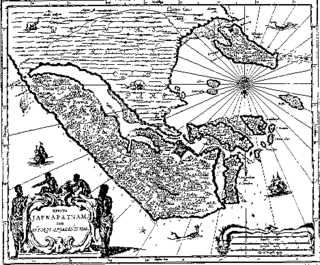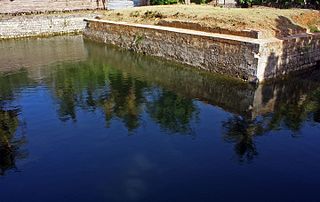
The Nallur Kandaswamy Kovil is a Hindu temple, located in Nallur, Northern Province, Sri Lanka. The presiding deity is Murugan (Kartikeya) in the form of the divine spear vel in the sanctum, the primary shrine, and in other forms, namely, Shanmugar, Muthukumaraswami, Valli Kanthar with consorts Valli and Deivayanai, and Dandayuddhapani, sans consorts in secondary shrines in the temple.

The Arya Chakravarti dynasty were kings of the Jaffna Kingdom in Sri Lanka. The earliest Sri Lankan sources, between 1277 and 1283, mention a military leader of this name as a minister in the services of the Pandyan Empire; he raided the western Sri Lankan coast and took the politically significant relic of the Buddha's tooth from the Sinhalese capital city of Yapahuwa. Political and military leaders of the same family name left a number of inscriptions in the modern-day Tamil Nadu state, with dates ranging from 1272 to 1305, during the late Pandyan Empire. According to contemporary native literature, such as Cekaracecekaramalai, the family also claimed lineage from the Tamil Brahmins of the prominent Hindu pilgrimage temple of Rameswaram in the modern Ramanathapuram District of India. They ruled the Jaffna kingdom from the 13th until the 17th century, when the last of the dynasty, Cankili II, was ousted by the Portuguese.

The Sinhala kingdom or Sinhalese kingdom refers to the successive Sinhalese kingdoms that existed in what is today Sri Lanka. The Sinhalese kingdoms are kingdoms known by the city at which its administrative centre was located. These are in chronological order: the kingdoms of Tambapanni, Upatissa Nuwara, Anuradhapura, Polonnaruwa, Dambadeniya, Gampola, Kotte, Sitawaka and Kandy.

Chandrabhanu or Chandrabhanu Sridhamaraja was the King of Tambralinga Kingdom in present-day Thailand, Malaysia and Sumatra and the Jaffna Kingdom in northern Sri Lanka. A Javaka, he was known to have ruled from during the period of 1230 until 1262. He was also known for building a well-known Buddhist stupa in southern Thailand. He spent more than 30 years in his attempt to conquer Sri Lanka. He was eventually defeated by the forces of the Pandyan Dynasty from Tamil Nadu in 1262 and was killed by the brother of the south Indian Emperor Jatavarman Sundara Pandyan.

Nallur is an affluent suburb in Jaffna, Sri Lanka. It is located 3 km south from Jaffna city centre. Nallur is most famous for Nallur Kandaswamy temple, one of Sri Lanka's most sacred place of pilgrimage for Sri Lankan Hindus. Nallur is also famous for being the historical capital of the old Jaffna Kingdom and birthplace of renowned philosopher and theologian, Arumuka Navalar.

Jaffna District is one of the 25 districts of Sri Lanka, the second level administrative division of the country. The district is administered by a District Secretariat headed by a District Secretary appointed by the central government of Sri Lanka. The capital of the district is the city of Jaffna.
Martanda Cinkaiariyan ascended the throne of Jaffna Kingdom under the throne name Pararasasekaram III. He is one of the early Aryacakravarti kings about whom historical and epigraphical evidence is available. He was noted by Ibn Battuta in his well-known travelogue as well as he has left behind a few inscriptions. He oversaw the international trade of the Jaffna kingdom with Yemen via the kingdom's powerful trading ships. Martanda Cinkaiariyan accompanied Battuta to the peak of Sivanoli Padam Malai along with Yogis and other Hindus and companions of the king who visited the sacred Shiva site annually.

The Vanni chieftaincies or Vanni tribes was a region between Anuradhapura and Jaffna, but also extending to along the eastern coast to Panama and Yala, during the Transitional and Kandyan periods of Sri Lanka. The heavily forested land was a collection of chieftaincies of principalities that were a collective buffer zone between the Jaffna Kingdom, in the north of Sri Lanka, and the Sinhalese kingdoms in the south. Traditionally the forest regions were ruled by Vedda rulers. Later on, the emergence of these chieftaincies was a direct result of the breakdown of central authority and the collapse of the Kingdom of Polonnaruwa in the 13th century, as well as the establishment of the Jaffna Kingdom in the Jaffna Peninsula. Control of this area was taken over by dispossessed Sinhalese nobles and chiefs of the South Indian military of Māgha of Kalinga (1215–1236), whose 1215 invasion of Polonnaruwa led to the kingdom's downfall. Sinhalese chieftaincies would lay on the northern border of the Sinhalese kingdom while the Tamil chieftaincies would border the Jaffna Kingdom and the remoter areas of the eastern coast, north western coast outside of the control of either kingdom.
Bhuvanekabahu VI of Kotte, also known as Sapumal Kumaraya and Chempaka Perumal, was an adopted son of Parakramabahu VI. His principal achievement was the conquest of Jaffna Kingdom, a historical kingdom of what today is northern Sri Lanka, in 1447 or 1450. Bhuvanaikabahu was apparently summoned south after the demise of his adopted father. He then ruled for 17 years. According to Rajavaliya, he killed the grandson of Parakrama Bahu VI, namely Vira Parakrama Bahu or Jaya Bahu.

The Portuguese conquest of the Jaffna kingdom occurred after Portuguese traders arrived at the rival Kotte kingdom in the southwest of modern Sri Lanka in 1505. Many kings of Jaffna, such as Cankili I, initially confronted the Portuguese in their attempts at converting the locals to Roman Catholicism, but eventually made peace with them.

Portuguese Ceylon is the name given to the territory on Ceylon, modern-day Sri Lanka, controlled by the Portuguese Empire between 1597 and 1658.

Jaffna is the capital city of the Northern Province of Sri Lanka. It is the administrative headquarters of the Jaffna District located on a peninsula of the same name. With a population of 88,138 in 2012, Jaffna is Sri Lanka's 12th most populous city. Jaffna is approximately ten kilometres from Kandarodai which served as an emporium in the Jaffna peninsula from classical antiquity. Jaffna's suburb Nallur served as the capital of the four-century-long medieval Tamil Jaffna Kingdom.
When to date the start of the history of the Jaffna kingdom is debated among historians.

The ruins of the Jaffna kingdom are the remains of the building structures of the Jaffna Kingdom, the royal abode and structure of the ruling dynasty of the kingdom of Jaffna, Nallur, Jaffna, in Northern Sri Lanka.
Dom Constantino was the child Portuguese puppet and last titular King of Jaffna in the 17th century, whose reign lasted from 1619 to 1624. He succeeded Cankili II. With the conquest of the Jaffna kingdom and the end of the monarch Dom Constantino was succeeded by Filipe de Oliveira, as Captain-major.

Portuguese invasion of Jaffna kingdom in 1591 AD was the second expedition against the Jaffna kingdom by the Portuguese. The campaign, led by Captain André Furtado de Mendonça, started from Mannar and continued to Nallur, the capital of the Jaffna kingdom. The Portuguese captured the kingdom, killed the king, and installed Ethirimana Cinkam as the new ruler.
The Portuguese invasion of Jaffna kingdom in 1560 AD was the first expedition against the Jaffna kingdom by the Portuguese Empire. It was led by Viceroy Dom Constantino de Bragança and resulted in the capture of the capital, Nallur. The king of Jaffna, Cankili I, managed to escape and regained the capital through a pact that he made with the Portuguese. He subsequently incited a peoples' rebellion against the Portuguese, resulting in their withdrawing their forces from Nallur. The Jaffna kingdom, however, lost its sovereignty over Mannar Island and its main town, Mannar.

Mantri Manai or Manthiri Manai is a historic palace situated in Nallur, Jaffna, Sri Lanka. It is one of the archaeological protected monuments in Jaffna District and was listed by the Sri Lankan government in 2007.

Yamuna Eri is an ancient pond situated in Nallur, Jaffna, Sri Lanka. In 1948, it was listed as one of the protected archaeological monuments in the Jaffna District by the Sri Lankan government.
The Kotte conquest of the Jaffna kingdom was an expedition against the Jaffna kingdom by the Kotte kingdom. The Kotte's campaign had several phases against Jaffna dated between A.D. 1449–50 and 1453–54. The first campaign, led by Prince Sapumal, adopted son of Parakramabahu VI in 1450. In the second campaign, Prince Sapuma defeated Kanakasooriya Cinkaiariyan and ruled the region nearly 17 years as a representative of Kotte.













